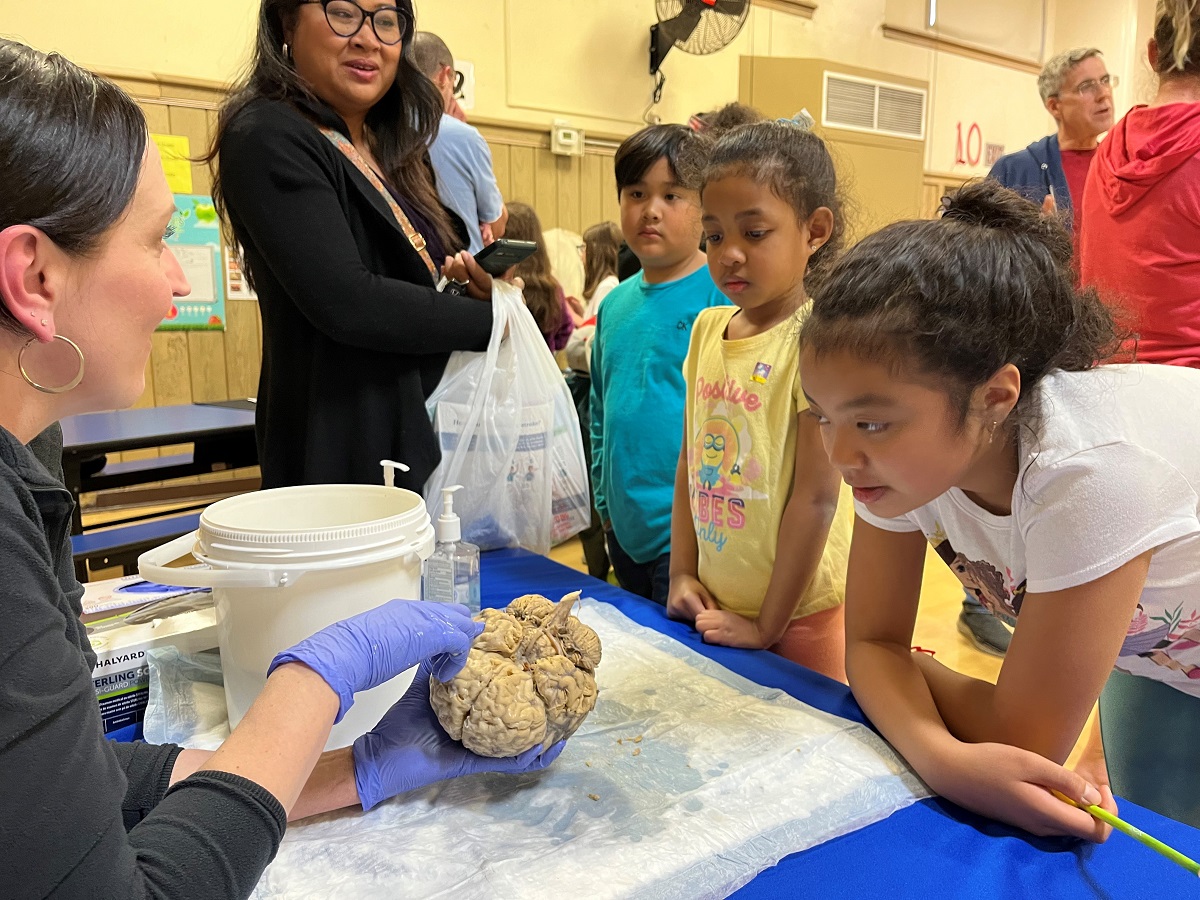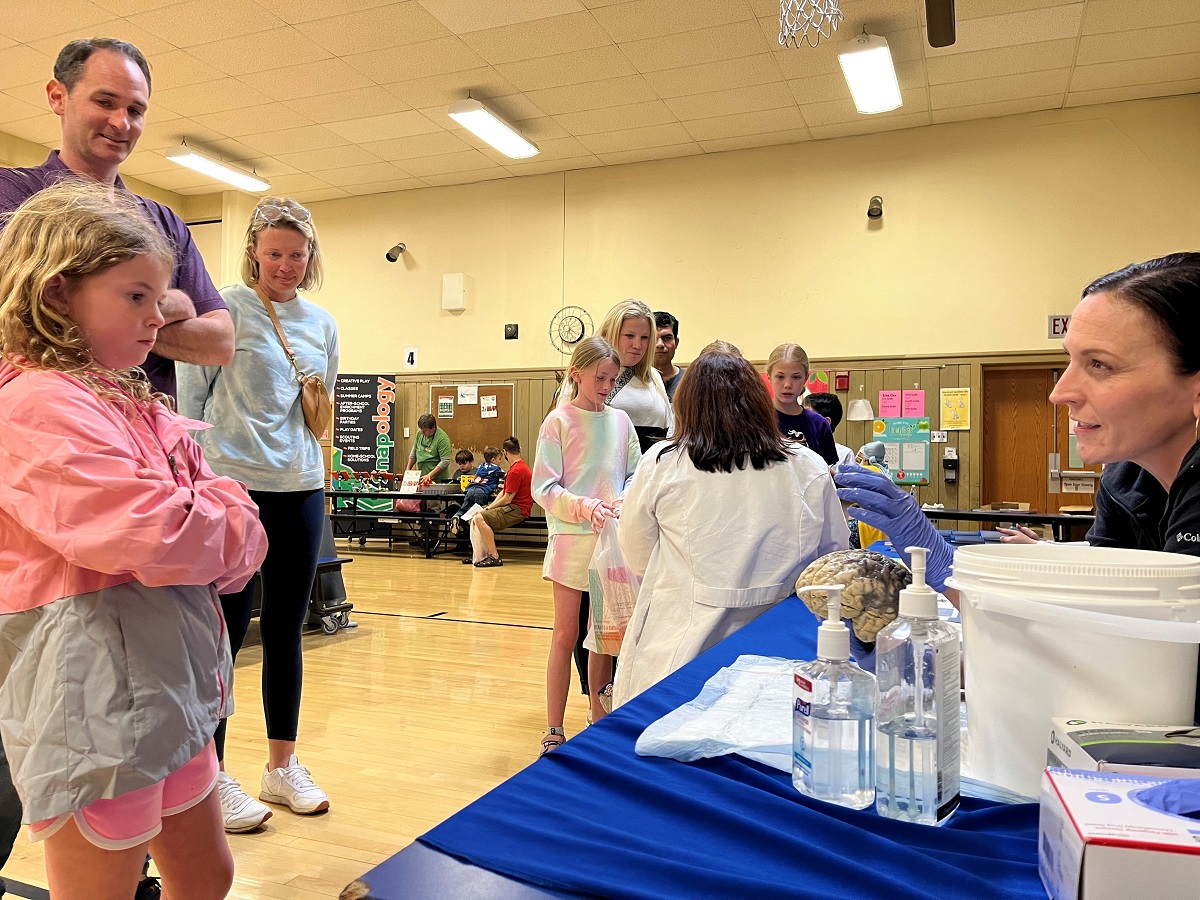Lessons for the mind: Penn State Health Milton S. Hershey Medical Center stroke team outreach focuses on stopping strokes

Sydney Finnell frowns at what Erin Cekovich is cradling in her gloved hands. It looks like a mammoth head of cauliflower, but gray, split down the center of its oval shape and dangling tubes.
“Have you ever seen a human brain before?” asks Cekovich, manager of the stroke program at Penn State Health Milton S. Hershey Medical Center.
The little girl stares. She crosses her arms and comes no closer. “Yeah,” she says.
“You have?” Cekovich says, smiling. “Where?”
“Right here,” Finnell says.
Cekovich laughs. Not everyone gathered at Paxtonia Elementary School in Harrisburg for Science Night is as skeptical about the Penn State Health brain as Finnell. In fact, for dozens of the local residents who gather for one evening every year to watch representatives from academia and local companies perform scientific experiments at the school, crowding in close and gawking at a naked human mind is tradition.
“It’s always my first stop,” one woman tells Cekovich, who is there with other members of Milton S. Hershey Medical Center’s stroke team.
But while the novelty of getting up close to the mysterious organ responsible for your dreams, fears and chocolate cravings is tantalizing, the stroke team isn’t there for thrills. The brain was a gift to the health system by an anonymous donor for education purposes. And Cekovich and her partners hope the lessons they teach will actually help save lives.
“Does anybody know what happens when you have a stroke?” Cekovich asks a pack of enraptured children.
She flips the brain over to where the brain stem, severed from the spinal cord, dangles. Sometimes a blood vessel bursts, she explains. That’s called a hemorrhagic stroke. Sometimes a blockage forms within an artery. That’s an ischemic stroke. Either way, the blood supply to the big computer inside your head becomes disrupted, and that can quickly lead to permanent damage.
Or worse ― death. And it can happen in a matter of seconds.
Cekovich and her partners are visiting Science Night for the same reason they drop by food pantries and other local gatherings ― to try to stop strokes from taking lives.
Someone has to make the call
Every 40 seconds, someone in the U.S. suffers a stroke, according to the U.S. Centers for Disease Control and Prevention (CDC). Every three minutes and 14 seconds, someone dies from one.
Early detection can make all the difference, and that’s the point of events like Science Night and others the stroke team regularly attends. In Penn State Health’s 2021 Community Health Needs Assessment survey, heart disease and stroke ranked fifth among health conditions affecting survey respondents. People most likely to suffer strokes struggle with high blood pressure, high cholesterol, smoking, obesity and diabetes, according to the CDC.
A stroke can kill in a moment and strike swiftly. But two things can prevent it.
One is a qualified health care team. Cesar Velasco says patients can find just that where he works as coordinator of the stroke program at Milton S. Hershey Medical Center. The medical center’s neurology and neurosurgery teams are available 24/7 to provide comprehensive stroke center interventions. This includes intravenous medication that dissolves clots and endovascular thrombectomy, a surgical procedure to remove a clot causing disruption of blood flow to the brain. These treatments are time sensitive and can only be delivered to patients who meet acute ischemic stroke treatment criteria. All of it starts, Velasco says, with a 911 phone call. And that’s where the second essential ingredient for preventing a fatal or damaging stroke comes into play – someone nearby who knows the warning signs.
BE FAST
“Who knows what BE FAST stands for?” Cekovich asks a scrum of children at Paxtonia Elementary who have gathered to say hi to the brain.
A boy in the crowd furrows his brow and begins.
“B is for balance,” he says.
“Good,” Cekovich says. Someone suffering a stroke may be unsteady on their feet.
“E is for eye.” A stroke could cause someone to lose their vision in one or both eyes.
“F is face,” the boy continues. A telltale sign can be a facial droop or an uneven smile.
“A is arms.” One arm might hang lower than the other in someone having a stroke.
“S is for speech.” Someone suffering a stroke might slur their words, have trouble speaking or seem confused.
“And T is … um …” The boy searches for it. Cekovich starts to give him the answer, but before she can say it, he blurts out the final word. “TIME,” he says.
“Right,” Cekovich nods. “Time to call 911. Fantastic!”
Her audience has seen the acronym many times ― at school, on billboards and posters ― but it’s the most essential part of the stroke team’s presentation. In March, they visited with hockey fans at the Hershey Bears game. This spring, they’re attending farmers markets and local food banks because “We want to integrate ourselves into communities that might not have equitable access to not only health care but also food,” Velasco said, since what you eat can contribute to your likelihood of having a stroke. Stroke team members do live interviews on TV and perform tests among samples of participants at some events to determine whether their message is getting through.
The idea is that just about anyone can make that 911 call – teachers, plumbers, CEOs or professional baseball players.
And children. Among the literature and brochures about strokes and what can be done to protect against them is a coloring book for kids all about how they can help.
‘People don’t know’
The brain they bring to events “is a good way of illustrating that this is an organ you don’t regularly see,” Velasco said. “We take for granted the ideas of brain health and the risk for stroke.”
For some at Science Night, the brain struck a personal chord. A woman watched Cekovich’s description of a stroke and explained to her child that her grandfather who they just visited in the hospital was suffering from a stroke.
David Klinger, a 64-year-old from Harrisburg, has had three strokes. Cekovich showed him on the underside of the brain what exactly had happened. He’d never been up close to the organ that had caused him so much trouble.
“It’s weird,” he said.
The first stroke came in 2016 when he was driving an 18-wheel tractor trailer on Interstate 78. He lost feeling in one of his feet.
His most recent stroke was five weeks ago. He wasn’t going to go to the hospital until his wife recognized the signs and made him go in. He’s thankful that she did.
“People don’t know,” he said. “They told me I wouldn’t walk after the first time.”
Educating members of our communities is part of the Penn State Health strategy to improve wellness and disease prevention. Learn more in the Penn State Health Community Health Needs Assessment and Implementation Plan.
If you're having trouble accessing this content, or would like it in another format, please email Penn State Health Marketing & Communications.

